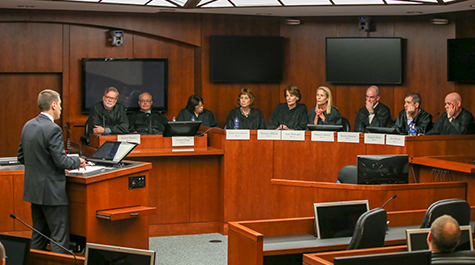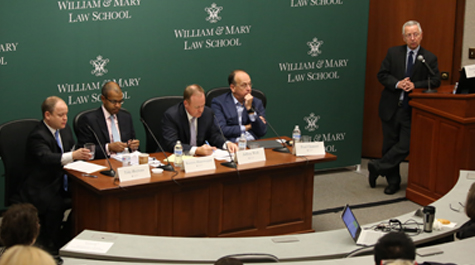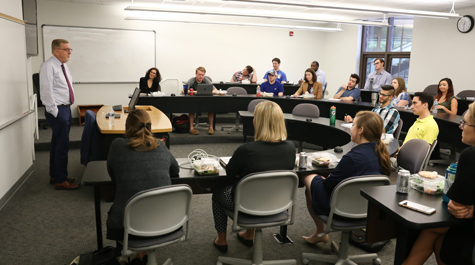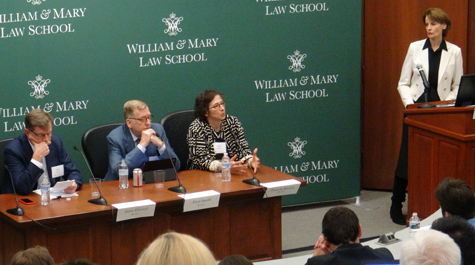William & Mary Law School’s Annual Supreme Court Preview opens with Moot Court
The Institute of Bill of Rights Law at William & Mary Law School hosted the 31st Supreme Court Preview on Sept. 21-22. The annual conference invites experts to talk about issues the Supreme Court will discuss in the upcoming term.
This year’s Preview featured four federal court of appeals judges, 16 Supreme Court advocates who have collectively argued more than 300 cases before the Supreme Court, and leading Supreme Court reporters and columnists from the nation’s top news outlets.
True to tradition, the Preview kicked off with a Moot Court, a mock trial of a pending United States Supreme Court case argued by two experienced Supreme Court advocates and judged by nine notable judges, lawyers, professors and journalists.
The case argued this year was Nieves v. Bartlett, which is set to be heard by the Supreme Court on Oct. 5. This case concerns the question of whether someone can sue for retaliatory arrest from a police officer if there was a probable cause to the arrest.
In the simulation, the officers were represented by William Jay, a partner at Goodwin Procter and head of the Litigation Department in the firm’s Washington, D.C., office. Bartlett was represented by Pamela Karlan, a professor at Stanford Law School and co-director of the school’s Supreme Court Litigation Clinic.
The justices hearing the arguments included Robert Barnes, a journalist at the Washington Post; Garrett Epps, a professor at the University of Baltimore School of Law; Linda Greenhouse, a professor at Yale Law School; Patricia Millett, a judge in the U.S. Court of Appeals, D.C. Circuit (who delivered the Law School’s Constitution Day lecture the previous day); Joan Biskupic, a journalist at CNN; Pamela Harris, a judge in the U.S. Court of Appeals, 4th Circuit; Kevin Newsom, a judge in the U.S. Court of Appeals, 11th Circuit; Gregory Stohr, a journalist at Bloomberg; and Jess Bravin, a journalist at The Wall Street Journal.
The case is on appeal from Alaska, where Russell Bartlett was charged with disorderly conduct, resisting arrest and assault after an altercation involving Troopers Luis Nieves and Bryce Weight. The troopers were investigating minors drinking alcohol at a party in 2014 when Bartlett demanded Weight stop the investigation while the trooper was talking to a minor. After a physical struggle from both sides, which was caught on camera, the troopers arrested Bartlett.
The original case brought against Bartlett by the state was dismissed by the district court for budgetary reasons. Bartlett subsequently brought a suit against the troopers, claiming, among other things, retaliatory arrest for protected First Amendment speech. The district ruled in favor of the officers because there was probable cause for the arrest. On appeal, the court ruled in favor of Bartlett, finding that probable cause does not negate a retaliatory arrest claim. The officers then appealed to the Supreme Court.
Jay, on behalf of the officers, argued that the plaintiff must prove the absence of probable cause to bring a retaliatory arrest claim. Karlan, on behalf of Bartlett, argued that this rule would allow officers to make up reasons for an arrest after the fact to bar the plaintiff from bringing the case.
The judges questioned both sides on the merits and downfalls of their arguments. Regarding the officers’ claim, the judges were concerned that all retaliatory arrest cases could be banned from courts in the future. On Bartlett’s claim, the judges raised concerns about possibly incentivizing people to talk back to the police to avoid charges.
The final decision was 7 to 2 in favor of Bartlett. The justices vacated the appellate court’s decisions and sent the case back down to allow that more evidence be considered in a new judgment.
In the majority opinion, Brevin said, “We agree that police are entitled to a good faith presumption if they make an arrest if they do have probable cause, but we do not think that the presumption is impossible to pierce.”
The Friday night programming also featured a panel on the nomination of Judge Brett Kavanaugh and its potential impact on the Supreme Court.
The Preview continued on Saturday, Sept. 22 with panels on Criminal Law, Business Law, Separation of Powers, and Civil Rights. Lunch breakout sessions included “Judging on the U.S. Court of Appeals,” “The Legal ‘Resistance’ to the Trump Administration,” and “The ‘Weaponizing’ of the First Amendment by Conservative Groups.”
Panelists considered the most interesting and important cases on the Court’s docket, as well as legal issues likely to be heading to the Supreme Court, nationwide injunctions and the relationship between higher and lower courts, and the Trump Department of Justice.
About the Institute of Bill of Rights Law
The Institute of Bill of Rights Law (IBRL) was established at William & Mary in 1982 to support research and education on the Constitution and the Bill of Rights. One of the principle missions of the Institute is to facilitate interaction between the professions of law and journalism. Through a discussion of key cases on the Supreme Court’s docket at the start of each term, the annual Supreme Court Preview provides in-depth education for journalists on the underlying issues to enhance press coverage of the decisions.
About William & Mary Law School
Thomas Jefferson founded William & Mary Law School in 1779 to train leaders for the new nation. Now in its third century, America's oldest law school continues its historic mission of educating citizen lawyers who are prepared both to lead and to serve.



